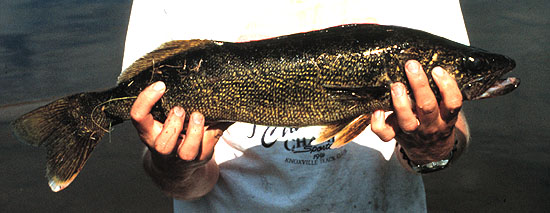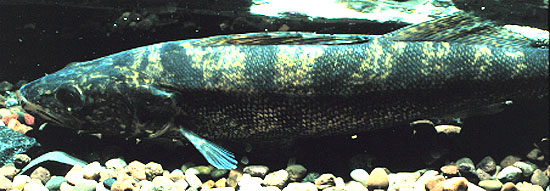|
|
|
|
What's
In a Name?
Walleye: given
because of the smoky, silvery eye, which is said to be similar to that
of blinded or "walleyed" domestic animals
Sander
(sand-er) refers to German common name for the European relative of walleye
vitreus (vit´-tree-us) means "glassy",
alluding to the nature of the large, silvery eyes
|
| |
|
|
|
|

|
|
|
Where
Do They Live?
Walleye occur in all major drainages of Minnesota, but they were probably introduced in the southwestern part of the state. Originally, they inhabited our larger lakes and rivers, but they have been introduced into thousands more. Minnesota's premiere walleye lakes include Lake of the Woods, Lake Mille Lacs, Leech Lake, Lake Winnibigoshish, Otter Tail Lake, Gull Lake, Lake Saganaga, and others. Large populations also exist in the Rainy, St. Louis, St. Croix, and Mississippi rivers. Walleye favor clear, cool and calm waters, but can occupy turbid (cloudy), warm, and flowing water if they have cooler, quieter waters they can retreat to in late summer. When water temperatures go over 22° C (72° F), walleye head for deeper, cooler water. |
| |
|
|
|
|

|
|
|
How
Big Do They Get?
How
Long Do They Live?
Walleye are the biggest member of the perch family, and females are usually
bigger than males of the same age. In Minnesota's premiere walleye lakes,
this species grows to 660 mm (26 in), and catches in the 380-480 mm (15-19
in) range are common. Walleye in these lakes often weigh 2.5-4 kg (6-9
lbs), with the rare fish reaching nearly 6.8 kg (15 lb). The state record
is a whopping 7.96-kg (17 lb 8 oz). It was caught in the Seagull River
in Cook County. The maximum age of walleye is in question. For decades,
biologists have aged walleye using their scales. We now know that scales
give poor records of age beyond 9-10 years. Recent work with spines (from
the first fin in the back) and otoliths ("ear" bone) show that walleye
often live beyond 20 years!
|
| |
|
|
|
|
|
|
|
What
Do They Eat?
Walleye are piscivores (fish-eaters) and will eat any species of fish they
can catch and swallow. Yellow perch and
many species of minnows and darters
are their most common food. Larval and young juvenile walleye consume copepods,
waterfleas, and small insect larvae, but quickly add larval fish to their
diets. |
| |
|
|
|
|
|
|
|
What
Eats Them?
Walleye of up to several years old are eaten by northern
pike, musky, largemouth
bass, and other larger walleye. Walleye are a favorite among many
anglers because of their tasty, flaky meat and the challenge of catching
a day limit. This results in a large annual harvest from Minnesota waters.
|
| |
|
|
|
|
|
|
|
How
Do They Reproduce?
Walleye spawn in April and early-May soon after ice-out and water temperatures
in the shallows reach 4-7° C (40-45° F). Walleye migrate from
large lakes and rivers into small streams where they look for shallow
gravel beds or areas of flooded vegetation. In lakes without good inlet
streams, they move into shallow, rocky areas near shore. Walleye normally
spawn during the night hours in about 0.3-1.5 m (1-5 ft) of water. Walleye
are broadcast spawners, which means they swim above the spawning substrate
(bottom material) and release their eggs and sperm into the water. Females
release 200-300 eggs at a time, while one or more males fertilize them.
This spawning act is repeated at roughly 5-minute intervals. A female
may release all her eggs in a single night or may spawn over a period
of several nights. Most males spawn for several nights. The fertilized
eggs fall to the bottom, where they stick to the gravel or other bottom
material. The parents give no care to the developing eggs (embryos actually)
or the larvae that hatch from them. The embryos hatch in about 1-3 weeks,
depending on the water temperature. In lakes, the larval walleye soon
move into the deep, open water, where they develop into juveniles at about
25-30 mm. At this size they often return to the near shore areas of the
lake, a movement pattern similar to the yellow perch.
"Cool Fact":
A female walleye produces anywhere from 40,000-250,000 eggs a season,
depending on her size and condition.
|
| |
|
|
|
|
|
|
|
Conservation
and Management
The walleye is the official state fish of Minnesota as well as the state's most popular sport fish. More people go fishing on the opening day of walleye season than any other day of the year. This day is referred to commonly as "The Fishing Opener", even though many species of fishes can be caught year round and some species, like bass, cannot be kept legally on the "Opener". The Minnesota Department of Natural Resources raises a huge number of walleye every year for stocking. Stocking efforts vary greatly across the state and often are done cooperatively with various Lake Associations (groups of property owners around a given lake). Many of these cooperative efforts have been very successful.
|
Permission is granted for the non-commercial educational
or scientific use of the text and images on this Web document. Please credit
the author or authors listed below.
Photographs by Konrad P. Schmidt
Text by Nicole Paulson & Jay T. Hatch in
cooperation with
the Minnesota Department of Natural Resources' MinnAqua Aquatic Program
This page developed with funds from the
MinnAqua Program
(Minnesota Department of Natural Resources, Division of Fisheries)
and the
Sport Fish Restoration
Program (Fish and Wildlife Service, US Department of the Interior)
Maintained by Jay T. Hatch
General College and James
Ford Bell Museum of Natural History
University of Minnesota, Minneapolis/St.
Paul



